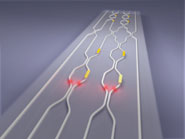The findings of this research constitute an important step forward in the race to develop a quantum computer

A multi-purpose optical chip capable of creating, changing and measuring quantum phenomena necessary for the construction of future quantum computers has been developed by researchers from the University of Bristol. The findings of this research constitute an important step forward in the race to develop a quantum computer.
The basic feature that enables the development of a quantum computer is quantum entanglement - the connection between two distant particles which Einstein called "strange action at a distance". The researchers from the University of Bristol have shown, for the first time ever, that this amazing phenomenon can be produced, modified and fully measured using a tiny silicon chip. The researchers also used the chip to measure the phenomenon known as "mixture" - an unwanted effect originating from the environment that often occurs, but one that can now be controlled and exploited for the benefit of characterizing quantum circuits, as well as a basic research area for physicists.
"In order to build a quantum computer, not only do we need the ability to control complex phenomena such as interweaving and mixing, but we also need the ability to do this by means of a chip inside which we can reproduce many such tiny circuits - to a large extent similar to modern computers that exist on the market today," says Professor Jeremy O'Brien, Director of the Center for Quantum Photonics. "Our device enables this and we believe that it is an important step forward towards the development of optical quantum computing."
The size of the chip, which performs several experiments that would normally be done individually using an optical device the size of a table, is 70 x 30 mm. It consists of a network of tiny channels that direct, route and react with single photons - the particles of light. Using eight reconfigurable electrodes embedded in the circuits themselves, pairs of photons can be routed and entangled to obtain any possible entangled state for two photons or any possible mixed state for a single photon.
"The situation is not optimal if your quantum computer is able to perform only one specific task," notes one of the researchers, who shared the research findings published in the scientific journal Nature Photonic. "We would prefer to develop a device that can be re-arranged and which is capable of performing a wide variety of tasks, in a manner similar to the desktop that runs on our personal computers today - this ability to re-arrange is what we have now demonstrated. This device is ten times more complex than previous experiments conducted using this technology. It is fascinating because we are able to conduct various experiments with it directly using a single chip."
The researchers, who have been developing quantum photon chips for the past six years, are now working on adjusting the device's complexity to a commercial level, and are testing the ability of this technology to serve as the building block for quantum computers of the future.

One response
Thanks, fascinating.
I would very much appreciate an article that explains a little more in depth the matter of the quantum computer, the challenges, the solutions and the existing theories.
Thanks.